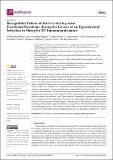Por favor, use este identificador para citar o enlazar a este item:
http://hdl.handle.net/10261/244912COMPARTIR / EXPORTAR:
 SHARE SHARE
 CORE
BASE CORE
BASE
|
|
| Visualizar otros formatos: MARC | Dublin Core | RDF | ORE | MODS | METS | DIDL | DATACITE | |

| Título: | Recognition pattern of the fasciola hepatica excretome/secretome during the course of an experimental infection in sheep by 2d immunoproteomics |
Autor: | Becerro Recio, David CSIC ORCID; González Miguel, Javier CSIC ORCID ; Ucero, Alberto CSIC ORCID; Sotillo, Javier; Martínez Moreno, Álvaro; Pérez Arévalo, José; Cwiklinski, Krystyna; Dalton, John P.; Siles Lucas, Mar CSIC ORCID | Palabras clave: | Fasciola hepatica Sheep Excretory/secretory antigens Immunoproteomics |
Fecha de publicación: | 2021 | Editor: | Multidisciplinary Digital Publishing Institute | Citación: | Pathogens 10(6): 725 (2021) | Resumen: | Excretory/secretory products released by helminth parasites have been widely studied for their diagnostic utility, immunomodulatory properties, as well as for their use as vaccines. Due to their location at the host/parasite interface, the characterization of parasite secretions is important to unravel the molecular interactions governing the relationships between helminth parasites and their hosts. In this study, the excretory/secretory products from adult worms of the trematode Fasciola hepatica (FhES) were employed in a combination of two-dimensional electrophoresis, immunoblot and mass spectrometry, to analyze the immune response elicited in sheep during the course of an experimental infection. Ten different immunogenic proteins from FhES recognized by serum samples from infected sheep at 4, 8, and/or 12 weeks post-infection were identified. Among these, different isoforms of cathepsin L and B, peroxiredoxin, calmodulin, or glutathione S-transferase were recognized from the beginning to the end of the experimental infection, suggesting their potential role as immunomodulatory antigens. Furthermore, four FhES proteins (C2H2-type domaincontaining protein, ferritin, superoxide dismutase, and globin-3) were identified for the first time as non-immunogenic proteins. These results may help to further understand host/parasite relationships in fasciolosis, and to identify potential diagnostic molecules and drug target candidates of F. hepatica. | Descripción: | 11 páginas, 1 figura, 1 tabla | Versión del editor: | http://dx.doi.org/10.3390/pathogens10060725 | URI: | http://hdl.handle.net/10261/244912 | DOI: | 10.3390/pathogens10060725 | E-ISSN: | 2076-0817 |
| Aparece en las colecciones: | (IRNASA) Artículos (MNCN) Artículos |
Ficheros en este ítem:
| Fichero | Descripción | Tamaño | Formato | |
|---|---|---|---|---|
| Recognition Pattern of the Fasciola hepatica.pdf | Artículo principal | 1,06 MB | Adobe PDF |  Visualizar/Abrir |
CORE Recommender
PubMed Central
Citations
7
checked on 12-mar-2024
SCOPUSTM
Citations
8
checked on 14-may-2024
WEB OF SCIENCETM
Citations
6
checked on 26-feb-2024
Page view(s)
75
checked on 22-may-2024
Download(s)
78
checked on 22-may-2024

